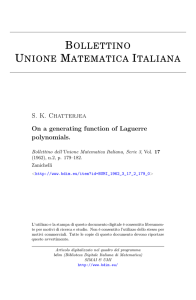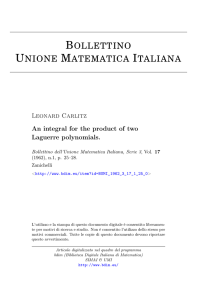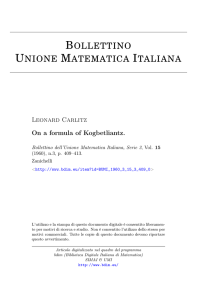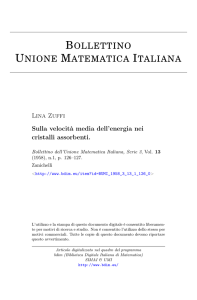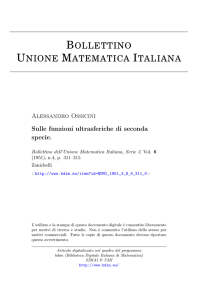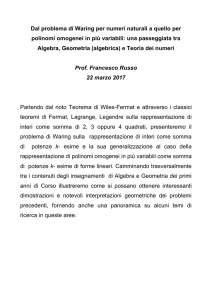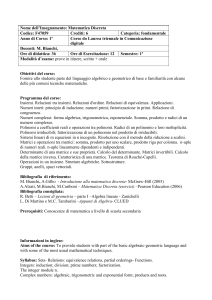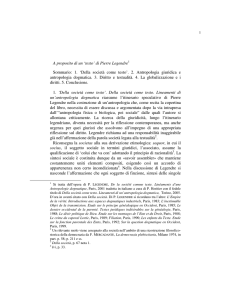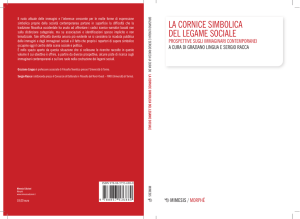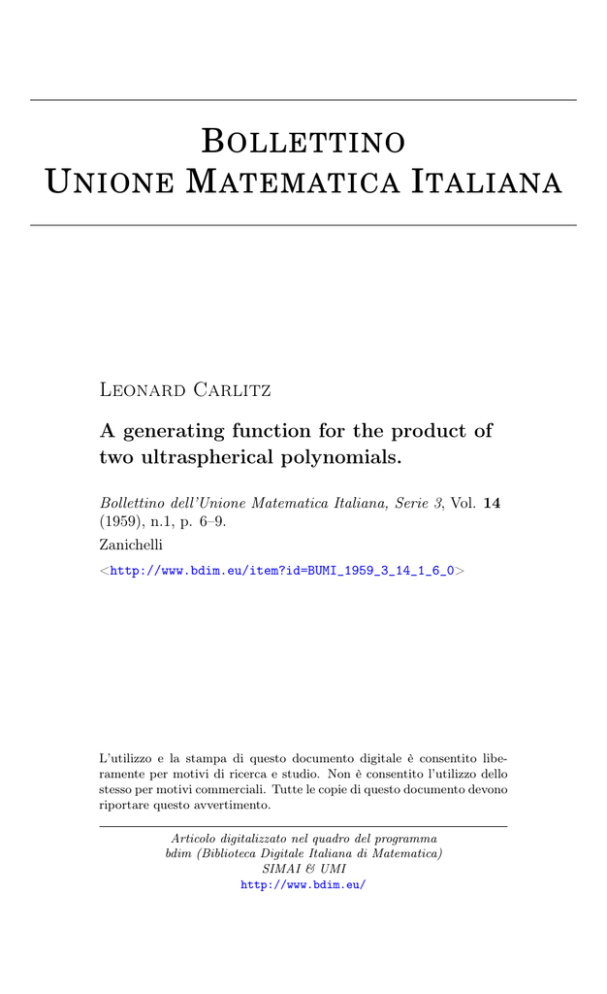
B OLLETTINO
U NIONE M ATEMATICA I TALIANA
Leonard Carlitz
A generating function for the product of
two ultraspherical polynomials.
Bollettino dell’Unione Matematica Italiana, Serie 3, Vol. 14
(1959), n.1, p. 6–9.
Zanichelli
<http://www.bdim.eu/item?id=BUMI_1959_3_14_1_6_0>
L’utilizzo e la stampa di questo documento digitale è consentito liberamente per motivi di ricerca e studio. Non è consentito l’utilizzo dello
stesso per motivi commerciali. Tutte le copie di questo documento devono
riportare questo avvertimento.
Articolo digitalizzato nel quadro del programma
bdim (Biblioteca Digitale Italiana di Matematica)
SIMAI & UMI
http://www.bdim.eu/
À générât ing fonction for thç product of two
ultraspherical poly nom fais.
Nota di
LÉONARD CARLITZ
(Duke TJniversity, U.S.A)
Santo. - Si gêneralizea una funsione génératrice del prodotto di due poli*
nomi di LEGENDRE, dovuta a L. 0. MÂXIMOK e si ottiene cosï una
funsione génératrice, del prodotto di due polinomi ultrasferici.
Summarj. - A generating function for the product of two Legendre polynomials due to L, C. MAXI MON is generalised to yield a generattng
function for the product of two ultraspherical poly nomials.
1. In a recent paper
formula
(1)
MAXÏMOX
S
[1] has proved the int ères tin g
3 n P M (co8a)P M (co6 6)
sin Û
where Pn{x) is the Legendre polynomial. It may be of interest
to note that (1) can be generalized ta
(2)
S 7^- ^Cnv(cos a)C„(cos Ö)
=
{ 1 — 2s cos (a -h p) H- z2 {
where Gn(x) is the ultraspherical polynomial defined by
(1 - 2 ^ -4- 0*)-* = 1 ^wC,tv(a;).
(S)
To prove (2) we make use of the formula (see for example
WATSON [2])
(4)
/ s i n ^ - ^ o ^ ^ c o s Q)do>
A GENERATING
FVNC'TIOX
FOR THK
PRODl CT, . ECC.
where
cos H = cos a cos |3 -h sin a sin Ö cos w.
I t follows from (3) and (4) that
t 1 — 23 COS O -+- 2*TV
L — 20[cos (a -+- fi) H- (1 — cos o>) sin % sin S] H- 0 2 | v
(on r e p l a c i n g t» b y -rr — o>)
= | 1 — 20 cos
40 sin a sin p sin 2 ^ w i
6 \
1-
^-^—^
!
1 — 20 COS (x -H p) -H 0"
M — 20 cos (a -4- p) -H 0 2 | - v
=
1 WL
The last intégral is equal to
7T
9
! fs
2 / s i n H *
Therefore
eos
J
o
* M * =
^
^
l (n -¥- 2v)
1»
712
S
u
T ^ - 0"C M v (cos a)C, t v (cos fi)
r (v +
f
=
r 2
S
| 1 — 20 cos (a -4- p) -f- z* i-v
(v)..(v)»i /
40 sin a sin p
LEOXAKD CARLITZ
(2) folloAvs at once.
2, It is clear from (2) that
f ~V znCnHcos x)<V(cos p)
o1 )
=
2 — ^ (40siuasin3)'(l — 2s cos (a-+-p) H=
S
V
, ^ ' (4gsiiiasiiift) r S s*C,v+*-(cos (a
J
^ U j - (4 sin a siu ?)" C;t;(cos (a -H p))
and therefore
(5)
nî
^ -
= JL £$&(4
sin sin )>c (c
* • »-
This formula is evidently equivalent to (2).
In particular for p = — a, (5) beconies
= JL ^ f e ( - 4sin'
since
the riglit member reduces to
r)!
^
) ( » ->- 2v)r
'
ti
A GKNEKAT1NG FUXCTION FOR THE PRODUCT, ECC.
Therefore we have
(6)
(C.v(a,))« =
This eau also be obtained directly from (2) with (3 = — a.
For
V
= Ô ' (ö) an< * (6) reduce to
(7)
Ptt(cos a)Ptt(cos p)
s ULUl
respectively.
If in (5) we take fi = a we get aaother formula for
On thé other hand if we take ? = 5 — a. then we get
^
CBv(>in a) = J
o
i
^
(28 in 2a)-
Since
Cy + 1 (0) = o,
c«lH(0) = ( - 1 ) - ^ ,
t h i s becomes
49)
^ - C
^"""^"T
(2 sin 2a)»-2-.
7
2
s!(n—2s)!(2v) n _ î /
If we prefer, the right member of (9) can be exhibited as an
=
S
(— 1)-
4Fd.
REFERENCES
[1] C. MAXLVION, A generating fonction for the product
of two
Legendre
polynomials, « Norsko Videnskabers Selskab Forhandlinger », vol. 29
(.1957), pp. 82-8ö.
[2] G. N. WATSON, Notes on generating fonctions of poîynomials; (3)
Polynomials of Legendre and Gegenbauer, «Journal of the London
Mathematical Society, vol. 8 (1933), pp. 289-292.

